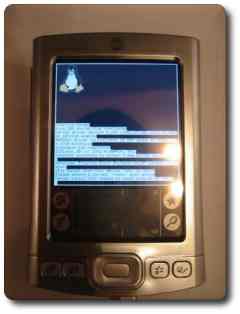Linux on the Tungsten E
 udovic Drolez has just reached out for
udovic Drolez has just reached out for nntp://comp.sys.palmtops.pilot and informed everyone that the Linux on Palm Tungsten E Project is now a success. Put in his own words:
Great news ! Some folks have managed to boot Linux on the Palm T|E.
A screenshot is available at http://palmtelinux.sourceforge.net/
This project might be confusing to some folks. Palm are committed to build upon the Linux kernel, whereas the project mentioned above is an exploitation of Palm hardware as to obtain a pure Linux device. It is rather encouraging to know that Palm handhelds are flexible enough to adapt to different environments.
Cited by: PalmAddict






 Filed under:
Filed under: 

 rofessionals have cowardly made discouraging statements recently. They will have you believe that Palm is lagging behind. They will attempt to persuade you that the future of Palm is uncertain.
rofessionals have cowardly made discouraging statements recently. They will have you believe that Palm is lagging behind. They will attempt to persuade you that the future of Palm is uncertain.
 ail archives organisation is a topic
ail archives organisation is a topic 
 Also on the same topic, it is rather frustrating that it took several years until Microsoft decided to fix the bugs inherent in Internet Explorer 6 and add valuable yet fundamental features like support for feeds. This move was a result of Firefox, of course, but more sadly,
Also on the same topic, it is rather frustrating that it took several years until Microsoft decided to fix the bugs inherent in Internet Explorer 6 and add valuable yet fundamental features like support for feeds. This move was a result of Firefox, of course, but more sadly, 

 ome time ago I came across
ome time ago I came across